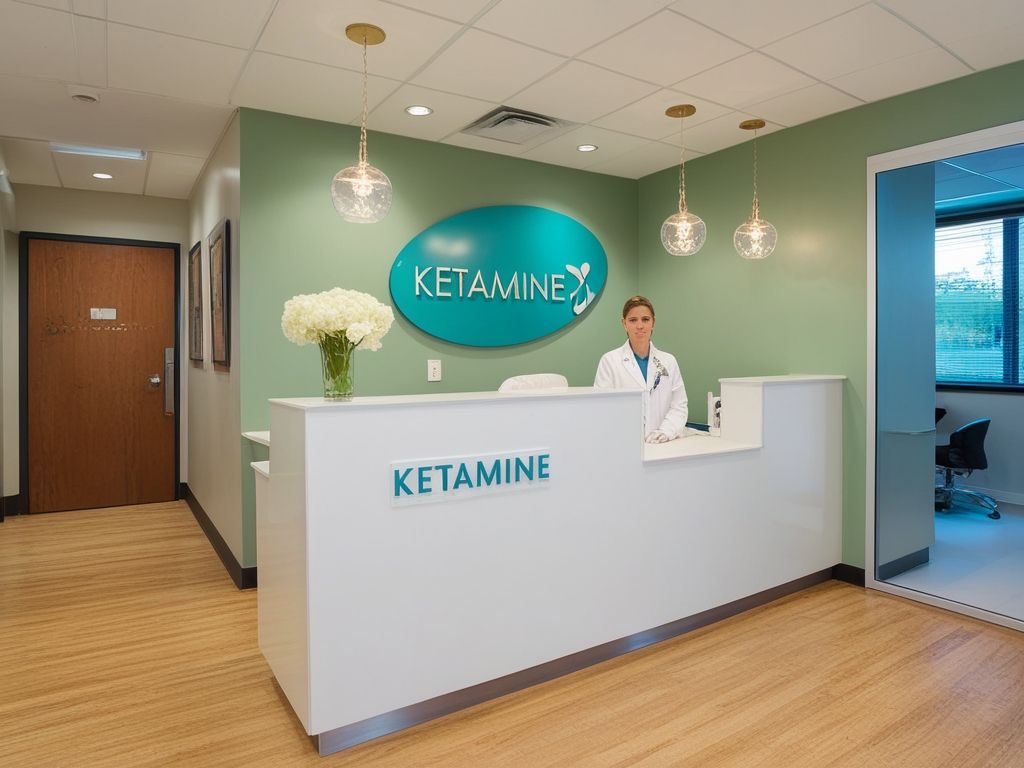
Welcome to the definitive guide on transforming your ketamine therapy clinic from a slow-moving “good idea” into a thriving hub of healing. Whether you’re a new provider establishing your presence, a traditional mental health professional integrating ketamine therapy into your practice, or an established clinic seeking to broaden your reach, this comprehensive guide will equip you with the knowledge and strategies needed to attract qualified ketamine therapy patients, avoid costly spending on non-target customers, and cultivate lasting growth.
Understanding the Unique Landscape of Ketamine Therapy
The prevalence of mental illness in the United States is significant, with nearly 50 million adults experiencing some form of mental health condition in 2022, according to SAMHSA. This translates to 19.86% of the adult population, with 4.91% experiencing severe mental health conditions. The growing number of individuals struggling with “treatment-resistant” mental health conditions, which are often unresponsive to traditional therapies, is fueling demand for alternative treatments like ketamine therapy. This demand is driven by the emerging evidence that ketamine therapy can effectively address these previously difficult-to-treat conditions.
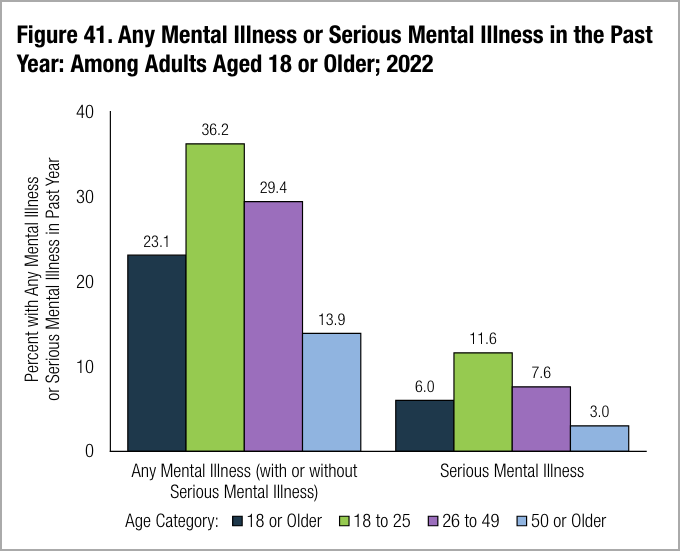
As awareness of ketamine therapy’s transformative potential grows, so too does the demand for qualified providers. And projections show providers are coming in droves. The ketamine therapy industry is expected to reach $6.90 billion by 2030, exhibiting a CAGR of 10.60%, from 2024 to 2030. This growth is driven by several factors, including the increasing aforementioned prevalence of mental health issues, a growing awareness of ketamine’s effectiveness in treating depression and other conditions, and a shift towards alternative treatment options.
Just as the demand for ketamine therapy is growing, so to is the nascent provider market and the need for providers to distinguish themselves from one another. It is essential to recognize that this is a niche market with specific ketamine therapy patient needs and concerns. Navigating this evolving landscape requires a nuanced understanding of both the opportunities and challenges inherent to attracting patients seeking alternative forms of mental health treatment and interested in ketamine therapy.
Challenges and Opportunities in Ketamine Therapy Patient Acquisition
The field of ketamine therapy presents a unique set of challenges and opportunities for providers seeking to attract the right patients to their practice. While the demand for this innovative treatment modality is undeniable, navigating the complexities of patient acquisition requires a strategic and patient-centric approach.
One of the primary challenges faced by ketamine therapy providers is the growing awareness of this treatment option among the general public. While media coverage, patient testimonials, and increasing research supporting the effectiveness of ketamine therapy have contributed to a broader understanding of its potential benefits, many individuals remain unaware or misinformed about its applications. In fact, a survey found that only 37% of adults in the U.S. were familiar with ketamine as a treatment for depression. This presents a significant opportunity for providers to step into the role of trusted educators, providing clear, accurate information about ketamine therapy and its potential to transform lives.
However, providers must also contend with the misconceptions and stigma surrounding ketamine’s history as an anesthetic and recreational drug. These preconceived notions can create apprehension and hesitancy among potential patients, making it crucial for providers to address these concerns head-on. By providing transparent, evidence-based information and cultivating a compassionate, professional environment, providers can help alleviate anxieties and build trust with their target audience.
As the field of ketamine therapy continues to expand, competition for patients seeking these specialized services also increases. To stand out in a crowded market, providers must embrace innovative marketing strategies that resonate with their ideal patient profile. Digital marketing, in particular, presents a powerful opportunity to reach a wider audience, engage potential patients, and build a strong online presence. By leveraging platforms such as social media, search engine optimization, and targeted advertising, ketamine therapy providers can effectively communicate the unique value proposition of their practice and attract the right individuals to their services.
Ultimately, the key to successful patient acquisition in the field of ketamine therapy lies in cultivating a patient-centric approach. By creating a welcoming, supportive environment that prioritizes patient education, comfort, and individualized care, providers can differentiate themselves from competitors and build lasting relationships with their patients. This approach not only helps attract new ketamine therapy patients but also fosters loyalty and positive word-of-mouth referrals, contributing to the long-term growth and success of the practice.
In navigating the challenges and opportunities of ketamine therapy patient acquisition, providers must remain adaptable, proactive, and committed to providing the highest quality of care. By staying abreast of the latest research, ketamine industry trends, and patient needs, providers can continually refine their acquisition strategies and ensure that they are effectively reaching and serving the individuals who stand to benefit most from this transformative treatment modality.
Patient Personas: Essential Steps Before Launching Your Patient Acquisition Strategy
Before diving into the intricacies of specific patient acquisition tactics, it is essential to establish a concrete foundation that will serve as the bedrock for all your future efforts. This foundational work is crucial, as it will guide and inform every aspect of your patient acquisition strategy, ensuring that your initiatives are cohesive, targeted, and ultimately effective in attracting the right individuals to your ketamine therapy practice.
Define Your Ideal Ketamine Therapy Patient
When developing your marketing strategy, it’s essential to have a clear understanding of your ideal ketamine therapy patient. By identifying the specific characteristics and needs of the individuals who are most likely to benefit from your services, you can effectively tailor your messaging, marketing channels, and overall approach to resonate deeply with your target audience.
Begin by identifying your specializations within the field of ketamine therapy. Determine the specific conditions you are most passionate about treating, such as depression, anxiety, PTSD, or chronic pain. By focusing on your areas of expertise, you can establish yourself as a trusted authority and attract patients who are seeking specialized care for their particular needs.
Next, consider the demographics and psychographics of your ideal ketamie therapy patient to build out patient personas. Determine factors such as age, gender, location, interests, and online behaviors. For example, if you specialize in treating depression in young adults, your ideal patient may be individuals aged 18-35 who are active on social media platforms and interested in holistic wellness approaches. Understanding these characteristics will help you create targeted marketing campaigns and select the most effective channels to reach your desired audience.
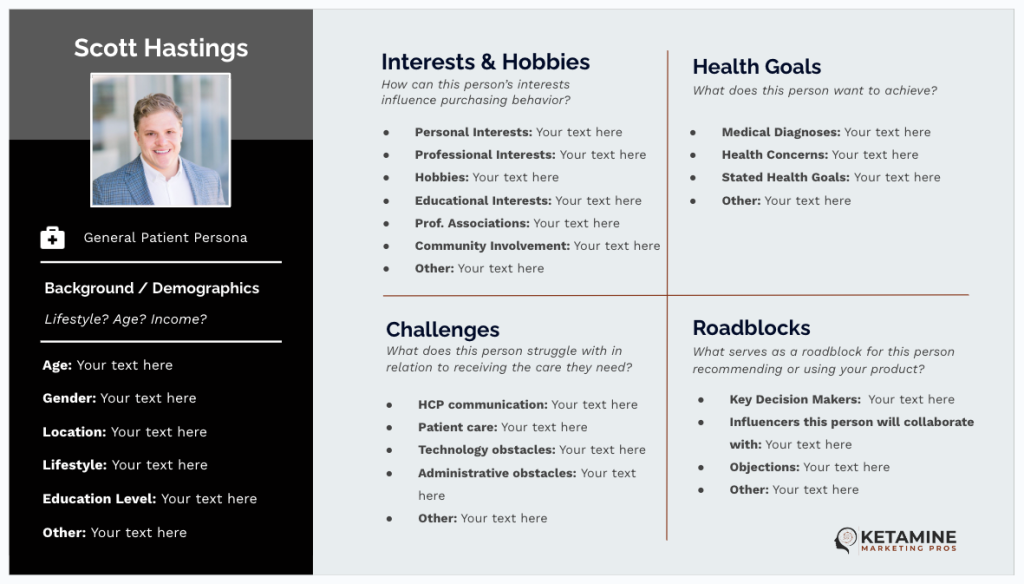
Finally, take the time to understand the typical patient journey for those seeking ketamine therapy. Consider the path a potential patient takes, from their initial research into treatment options to the moment they decide to seek professional help. By mapping out this journey, you can identify key touchpoints where you can engage with potential patients, provide valuable information, and guide them towards choosing your clinic for their ketamine therapy needs.
By clearly defining your ideal ketamine therapy patient, you lay the foundation for a highly effective marketing strategy. With a deep understanding of your target audience, you can create compelling messaging, select the most impactful marketing channels, and ultimately attract the individuals who are most likely to benefit from your expertise and care. This targeted approach not only helps you stand out in a competitive market but also ensures that you are connecting with the patients who need your services the most.
Craft a Compelling Ketamine Treatment Provider Brand Identity
Your brand identity serves as the heart and soul of your clinic, setting you apart in a competitive landscape. It encompasses your core values, unique value proposition, and visual identity. Crafting a strong brand identity is crucial for building trust, fostering recognition, and making your clinic memorable to your target audience. In fact, a study found that 64% of consumers cite shared values as the primary reason they have a relationship with a brand.
When defining your core values, consider the guiding principles that shape your approach to patient care. These may include compassion, empathy, innovation, and a focus on holistic wellness. Your core values should reflect the essence of your clinic and the philosophy that drives your team’s dedication to providing exceptional care. The aforementioned survey revealed that 94% of consumers would be highly likely to recommend a brand they perceive as having a strong purpose.
Willis-Knighton Health took an unconventional approach to branding by introducing “Willis the Bear,” a lovable teddy bear mascot designed to promote their labor and delivery services. While this unique branding strategy deviates from traditional healthcare marketing practices, it holds significant value in enhancing the institution’s overall brand identity.

By incorporating Willis the Bear into their branding efforts, Willis-Knighton Health not only amplified the impact of their collective branding initiatives but also created a memorable and engaging brand experience for patients. This innovative approach to branding helps to differentiate the institution from competitors, foster a warm and welcoming atmosphere, and ultimately contribute to a positive and comforting experience for expectant mothers and their families during their labor and delivery journey.
Your unique value proposition is what makes your clinic stand out from others in the field. It could be your specialized expertise in a particular area of medicine, your commitment to creating personalized treatment plans tailored to each patient’s needs, or the warm and welcoming environment you cultivate within your clinic walls. Identifying and communicating your unique value proposition helps potential patients understand why they should choose your clinic over others.
Fifty-five percent of consumers said they pay more attention to brand values than they did a year earlier. In an increasingly socially-conscious world, your brand values can be the catalyst to building trust, creating loyalty, and ultimately driving customer engagement.
Establish a Powerful Online Presence with an Exceptional Website
Your visual identity is the face of your brand, encompassing your logo, color palette, and imagery. These elements should be carefully chosen to reflect your brand personality and resonate with your target audience. A well-designed visual identity creates a lasting impression and helps patients instantly recognize and connect with your clinic. Research shows that color alone can increase brand recognition by up to 80%.
To establish a robust online presence, start by building a well-designed and user-friendly website for your ketamine clinic. According to a survey published by Stanford University, 75% of people judge a business’s credibility based on its website design. Make sure your website is contemporary-looking (no gradient text), easy to navigate, loads quickly, and provides clear information about the services you offer.
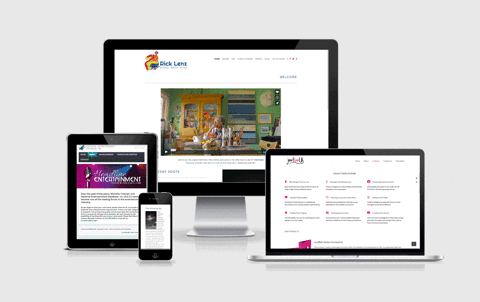
Include a dedicated page for ketamine therapy, where visitors can learn about the treatment process, its benefits, and the conditions it can treat.
Start by identifying the specific pain points and challenges that your target audience faces when it comes to mental health. Research by Demand Metric reveals that content marketing generates three times as many leads as traditional outbound marketing while costing 62% less. Create blog posts, videos, infographics, and podcasts that address these pain points and provide educational content about ketamine therapy.
Beyond Foundation: Generate and Publish Remarkable Content
According to HubSpot, businesses that blog receive 55% more website visitors on average than those that don’t. Incorporating a blog section on your website, and consistently filling it with exceptional multimedia content is essential to your clinic’s success.
Develop a Content Strategy
To effectively reach and engage your target audience, it’s essential to develop a comprehensive content strategy. Begin by identifying the topics, questions, and concerns that are most relevant to potential ketamine therapy patients. Conduct research, analyze search trends, and gather feedback from existing patients to gain insights into the information your audience is seeking. Once you have a clear understanding of your audience’s needs, create a content calendar to plan and schedule your content creation and distribution. A well-organized content calendar ensures a consistent flow of valuable information and helps you maintain a strong online presence.
Create High-Quality Content
With your content strategy in place, focus on creating high-quality, informative, and engaging content that educates potential patients about ketamine therapy. It’s what the inventors of inbound marketing call “remarkable” content. Write blog posts, articles, and website content that addresses common questions, concerns, and misconceptions surrounding the treatment. Use clear, concise language and break down complex concepts into easily digestible pieces of information. In addition to written content, develop downloadable resources, such as e-books, guides, and checklists, that provide in-depth information and actionable advice for individuals considering ketamine therapy. These resources not only demonstrate your expertise but also serve as valuable lead magnets, encouraging potential patients to engage with your clinic.
Publishing regular blog posts about ketamine therapy, mental health, and related topics positions your clinic as a reliable source of information and helps attract organic traffic to your website. Other blog topics might include:
- Industry news editorial
- Clinic news
- Employee spotlights
- Newsletter summaries
- Social media spotlights
To further enhance your content offerings, produce high-quality videos that explain ketamine therapy, share patient success stories, and answer frequently asked questions. Video content is highly engaging and can help build trust and credibility with your audience. Consider creating a series of short, informative videos that cover various aspects of ketamine therapy, from the science behind the treatment to what patients can expect during and after their sessions. By providing a mix of written, visual, and downloadable content, you cater to different learning preferences and increase the likelihood of attracting and engaging potential patients.
Incorporate patient success stories in your content marketing efforts. According to a study conducted by BrightLocal, 88% of consumers trust online reviews as much as personal recommendations. Sharing testimonials from patients who have benefited from ketamine therapy can build trust and create an emotional connection with potential patients.
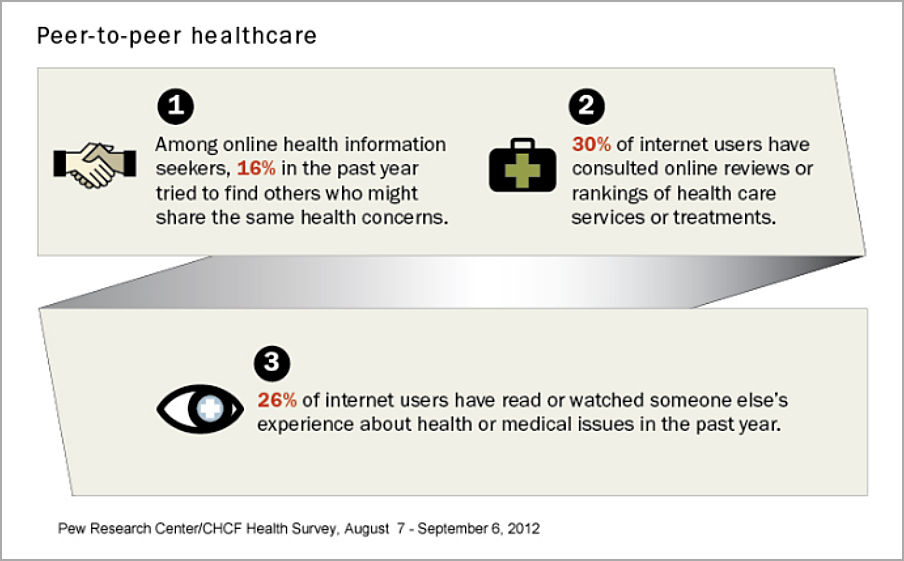
By creating valuable and informative content, you can establish your clinic as an authority in the field and address the questions and concerns that potential patients may have.
Mastering the Art of Local Search Engine Optimization (SEO)
Invest in search engine optimization (SEO) strategies to increase your online visibility and attract potential patients seeking ketamine therapy. Research by Ignite Visibility shows that 93% of online experiences begin with a search engine. As such, search engine optimization (SEO) is the cornerstone of attracting qualified ketamine therapy patient leads through organic search results, as the top organic search result on Google has an average click-through rate of 31.7%.
To effectively implement SEO, begin by conducting thorough keyword research. Identify the specific terms and phrases that potential patients are using when searching for information about ketamine therapy. Tools like Google Keyword Planner and SEMrush can help you uncover valuable insights into search volume, competition, and related keywords, such as:
- Treatment-resistant mental health
- Major depression disorder
- Severe anxiety
- Psychedelic-assisted therapy
- Mental health awareness
Once you have identified the most relevant and high-traffic keywords, naturally integrate them into your website content, meta descriptions, page titles, and image alt text. This will help search engines understand the context and relevance of your website, increasing the likelihood of your clinic appearing in search results. Research shows that websites with optimized meta descriptions can achieve a 5.8% higher click-through rate compared to those without.
As a ketamine therapy clinic, your focus should concentrate on local search.
Your Google Business Profile (GBP) is your ketamine clinic’s best results and ROI-generating search tool. By optimizing your GBP and ensuring your clinic appears in local search results and on Google Maps, you make it easier for nearby patients to find and choose your ketamine therapy practice. Learn how to set-up and optimize your ketamine practice GBP and consistently maintain it in the blog post below.
Execute on Your Social Media Marketing Strategy
“To be or not to be social,” is the frequent question of ketamine health providers.
The truth is, the ketamine providers and clinics that use social media channels see greater client conversion than those who don’t. 75% of internet users use social media to research brands, according to Data Reportal.

Have a look at popular social networks, and you’ll find discourse about ketamine therapy and related accounts are becoming more and more common. Ketamine resource provider, Journey Clinical, for example, has amassed nearly 7,000 Instagram followers. It’s not uncommon to see ketamine advertising on social networks, and forward-thinking ketamine clinics have used these channels to successfully reach their audiences.
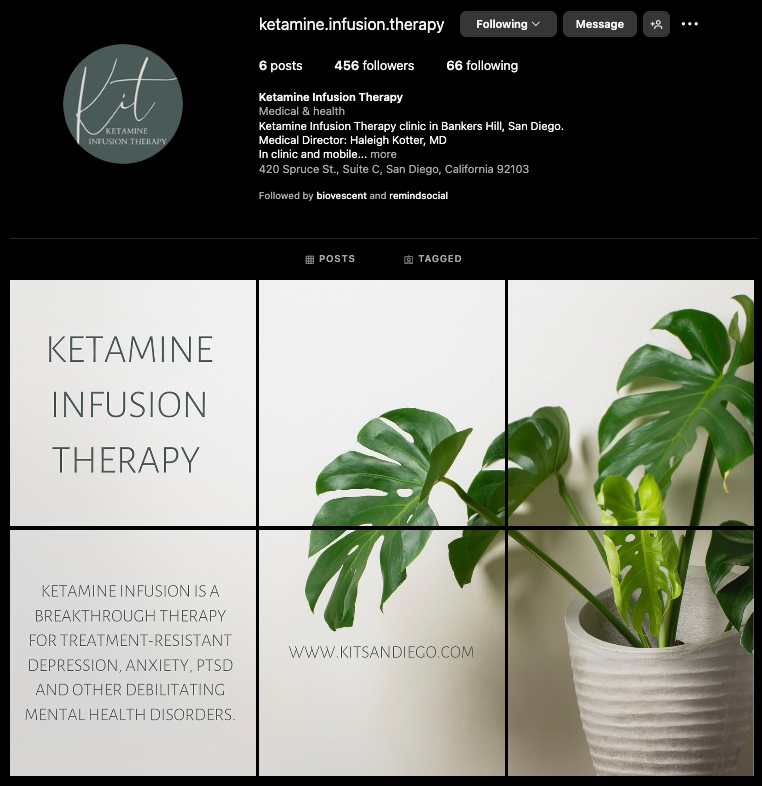
Share snippets from your blog posts, videos, and patient testimonials. Engage with your content by asking questions, running polls, and responding to comments. Check AI-powered and effective software applications that can assist your workflow.
Use social media channels to distribute your content and engage with your audience. Instagram and Facebook to reach prospective patients, LinkedIn to develop professional relationships and potential referral partnerships.
Share snippets from your blog posts, videos, and patient testimonials. Engage with your content by asking questions, running polls, and responding to comments.Use social media channels to distribute your content and engage with your audience. Share snippets from your blog posts, videos, and patient testimonials. Engage with your content by asking questions, running polls, and responding to comments.
Regularly share educational content, patient success stories, and updates about your clinic on social media. According to Sprout Social, 66% of consumers believe it’s important for brands to take a public stance on social and political issues. Don’t shy away from participating in conversations surrounding mental health, debunking myths about ketamine therapy, like:
- Ketamine is a horse tranquilizer and it isn’t suitable for human use
- Ketamine will make you “trip” or have hallucinations
- Ketamine is a party drug
- Ketamine is often addictive
- Ketamine is not an effective treatment for mental illnesses
Other ketamine myths busted surround the efficacy of ketamine in persons with Intrahepatic cholestasis of pregnancy (ICP) or Intraocular pressure (IOP), the fluid pressure of the eye, and other conditions.
Use eye-catching visuals, such as infographics, videos, and quality images, to make your social media posts more visually appealing and shareable. Engage with your audience by responding to comments, messages, and mentions on social media. Promptly addressing queries and actively participating in conversations demonstrates your clinic’s commitment to patient care and builds trust and rapport with potential patients.
Build Relationships and Referral Partnerships with Other Health Professionals
Developing relationships with mental health professionals can be a valuable strategy for attracting ketamine therapy patients to your clinic. Referrals from trusted professionals in the field can build credibility and increase patient trust in your clinic’s services. According to a study published in the Journal of General Internal Medicine, 82% of patients believe that clinician-to-clinician communication is important for optimal healthcare.
Start by identifying mental health professionals in your local area who may encounter patients who could benefit from ketamine therapy. This includes psychiatrists, therapists, psychologists, and primary care physicians. Reach out to these professionals through email or phone calls to introduce your clinic, its services, and the potential benefits of ketamine therapy.
Offer to provide informational materials to referral partners, such as brochures, research articles, or pamphlets that they can share with their patients. You can also invite them to visit your clinic for a tour or a meet-and-greet with your staff. These efforts demonstrate your commitment to collaboration and open communication, fostering trust and making it more likely for them to refer patients to your clinic.
Maintain ongoing communication with your referral partners through regular updates on new research, treatment protocols, and patient success stories. Consider organizing collaborative events, such as lunch and learns or professional development sessions, where you can share insight into ketamine therapy and answer any questions or concerns they may have. By cultivating strong relationships with referral partners, you can create a network of trusted professionals who are more likely to refer patients to your clinic.
Host Educational Events: Omnichannel Engagement
Educational events, whether in-person or virtual, offer a valuable opportunity to educate potential ketamine therapy patients about the treatment and your clinic’s services. These events provide a platform for you to establish credibility, address concerns, and build relationships with prospective clients who may be considering ketamine therapy. In fact, 67% of healthcare marketers believe that educational content is the most effective way to engage and convert potential patients.
Mental health webinars and podcasts have gained popularity, as they provide convenience and accessibility to a broader audience. Consider hosting a mixture of both formats to accommodate different preferences and reach a wider range of potential patients. Studies show that webinar attendance has increased by 47% since the start of the COVID-19 pandemic, with 91% of attendees believing that webinars are an effective educational tool. Additionally, 32% of Americans aged 12 and older have listened to a podcast in the past month, highlighting the growing popularity of this medium.

Research indicates that event-related emails generate a 28% open rate and a 4.8% click-through rate, making email marketing an effective tool for promoting your events. Craft compelling event descriptions that highlight the benefits of ketamine therapy, the speakers’ expertise, and the takeaways attendees can expect. Utilize testimonials and success stories from past patients to add credibility and inspire potential attendees.
During the event, provide valuable and informative content about ketamine therapy. Incorporate visuals, case studies, and expert insights to engage and inform attendees. Encourage questions and interactive discussions to address specific concerns or misconceptions about ketamine therapy. Offering a Q&A session with your clinic’s practitioners can further enhance attendees’ understanding and establish trust. A survey found that 92% of webinar attendees want a live question and answer session at the end of a webinar.
After the event, follow up with attendees by providing additional resources, such as downloadable guides or contact information for scheduling consultations. Engage with them on social media or through email marketing to maintain the connection and nurture them towards becoming patients at your clinic. Personalized email campaigns have an average open rate of 18.8% and a click-through rate of 2.1%, demonstrating the effectiveness of targeted follow-up communication.
By hosting educational events, you can effectively engage potential patients, establish your clinic as a trusted authority in ketamine therapy, and ultimately drive more individuals to seek treatment at your practice.
Nurture Relationships and Drive Conversions with Email Marketing
Email marketing remains a highly effective way to nurture relationships with potential patients, provide valuable information, and promote your services. With an average return on investment (ROI) of $42 for every $1 spent , email marketing is a cost-effective method for ketamine clinic to build lasting connections with your target audience and drive conversions.

Build Your Email List
To begin your email marketing efforts, focus on building a robust email list of individuals interested in ketamine therapy. Offer valuable content, such as e-books, guides, or checklists, in exchange for email sign-ups. These lead magnets should provide in-depth information on ketamine therapy, its benefits, and what patients can expect during treatment. By delivering value upfront, you encourage potential patients to trust your clinic and engage with your content. Additionally, include a clear and prominent email signup form on your website, making it easy for visitors to join your mailing list. Ensure that your signup form is visible on key pages, such as your homepage, blog, and service pages, to maximize conversions.
Segment Your Audience
As your email list grows, it’s essential to segment your audience based on their interests, demographics, or engagement level. Segmentation allows you to deliver more personalized and relevant content to each group, increasing the likelihood of engagement and conversion. For example, you might create separate segments for individuals interested in ketamine therapy for depression, anxiety, or chronic pain. By tailoring your content to each segment’s specific needs and concerns, you demonstrate your understanding of their unique challenges and position your clinic as the ideal solution. Studies show that segmented email campaigns have an open rate 14.32% higher than non-segmented campaigns, highlighting the importance of personalization in email marketing.
Provide Value with Every Email
To maintain a high level of engagement with your email list, ensure that every email you send provides genuine value to your recipients. Share informative content, such as blog posts, videos, or infographics, that educate your audience about ketamine therapy and its potential benefits. Keep your subscribers updated on clinic news, such as new staff members, expanded services, or upcoming events.
Occasionally, include special offers or promotions to encourage recipients to take action, such as scheduling a consultation or attending a webinar. However, avoid overly promotional language and always prioritize providing value and building relationships over making a hard sell. By consistently delivering valuable content, you establish your clinic as a trusted resource and increase the likelihood of converting subscribers into patients.

Nurture Leads
Finally, use email marketing to nurture leads and guide them through the patient journey. Develop automated email sequences that deliver targeted content based on a subscriber’s actions or interests. For example, when someone downloads your ebook on ketamine therapy for depression, enroll them in a sequence that provides additional information on the topic, shares patient success stories, and encourages them to schedule a consultation. By providing relevant, timely information and gradually guiding subscribers towards taking action, you can effectively nurture leads and convert them into patients. Research shows that lead nurturing emails generate an 8% click-through rate compared to general email sends, which generate just a 3% click-through rate, underscoring the power of targeted, automated email sequences in driving conversions.
Targeted Paid Advertising Campaigns for More Leads
Attracting qualified patients is a journey that calls for a multifarious strategy, a drive to perfection, and a great will to provide compassionate, patient-centered treatment. Adopting the techniques described in this guide will help you to position your ketamine therapy clinic for sustainable development, attract a larger audience of people looking for transforming healing, and significantly improve the quality of life of people suffering with mental health and chronic pain disorders. Recall that developing a strong practice calls for time, work, and regular activity. Never undervalue the power of real connection and compassionate care; keep educated about industry trends, modify your plans as needed.
Google Advertisements
Reaching possible patients who are actively searching for ketamine therapy-related keywords is made possible by Google Ads. Targeting particular search terms, such “ketamine therapy for depression” or “ketamine clinic near me,” helps to guarantee that your advertising show up before people most likely to convert. Write interesting ad content emphasizing the special value proposition of your clinic—that which is your knowledge, patient success rates, or creative treatment method. Strong calls to action (CTAs) will inspire clicks and generate website or dedicated landing page traffic. Google advertising are worth looking at since 75% of people say sponsored search advertising helps them locate the information they are looking for more easily.
Advertising on Social Media
Social media advertising might be a great approach to draw fresh patients to your clinic since 78% of American customers claim that posts on social media affect their buying choices. Ketamine therapy advertising can be seen on Facebook and Instagram where advanced targeting choices that let you access particular groups, hobbies, and activities to hone in on those open to treatment. To maximize ad targeting to individuals most likely to benefit from ketamine treatment, apply the patient personas offered in this article.
To find what appeals most to your target market, try several ad formats—from dynamic picture advertisements to creative video commercials to carousel ads. To draw in people and explain the advantages of your offerings, use striking images and persuasive language.
Advertisement Retargeting
Retargeting is a useful strategy for generating leads and driving patient acquisition since studies reveal that retargeted advertising are 70% more likely than normal display ads to convert. As these people surf other websites or social media, you can show tailored adverts by including a tracking pixel on your website. Retargeting supports conversions from people who have already indicated interest in your offerings and helps keep your clinic top-of-mind.
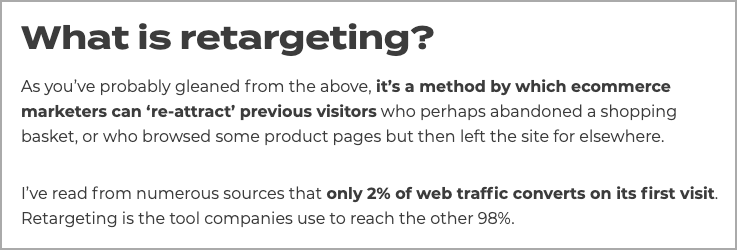
To encourage conversions, show certain benefits using retargeting advertising, publish patient testimonials, or run special offers. Review metrics and performance data often—click-through rates, conversion rates, cost per acquisition—to find areas for development and guarantee that your return on investment is good. Your paid advertising efforts will be most effective and lasting growth for your ketamine treatment facility will be driven by constant improvement of your targeting, ad copy, and landing pages.
Going Forward
Attracting ketamine treatment patients effectively calls for strategy and a multifarious method. Establishing a strong online presence, applying content marketing, using social media channels, developing relationships with referral partners, and organizing instructional events will help your clinic to project itself as a reliable source and draw patients looking for efficient mental health treatments.
Implementing effective strategies depends mostly on knowing the needs and preferences of your target audience, keeping current with research and industry advances, and keeping open lines of contact. Your clinic will stand out and create a strong patient base for your ketamine treatment operations by investing in marketing initiatives that give education, empathy, and creating trust first priority.
Ready to Take Your Ketamine Clinic to the Next Level?
The future of mental health care is here—and ketamine therapy is leading the way. But to truly thrive, your clinic needs to be visible in your community, earn patient trust, and communicate its life-changing potential effectively. That’s what we’re here to help you accomplish.
Partnering with Ketamine Marketing Pros is more than just an investment in marketing; it’s an investment in your clinic’s growth, credibility, and ability to make a difference in patients’ lives. Let us help you attract more patients, increase your revenue, and position your clinic as a leader in the field of mental health and alternative therapies.
Contact Us Today for a FREE Marketing Consultation!




